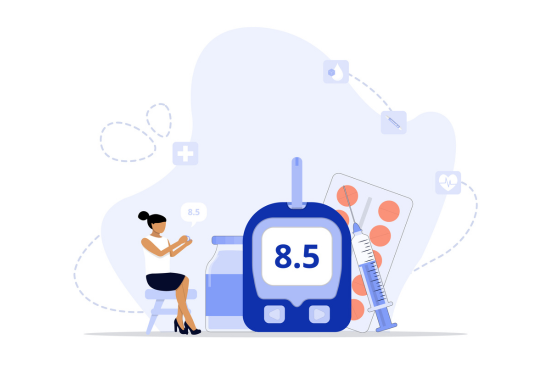Understanding Type 2 Diabetes: Causes, Symptoms, and Treatment Options

Achieving Freedom from Diabetes: Steps to Reverse the Condition
07 Jun 2024
For years, research has said that diabetes cannot be cured. It has led diabetes patients to believe that they have to always live like prisoners of their condition. Luckily, there’s a way you can reverse your diabetes and achieve freedom from diabetes. Yes, it’s possible.
How does Diabetes Reversal happen?
When you take the appropriate steps to bring your glucose levels down to a non-diabetic range without diabetic medications, diabetes reversal happens. Remember though, that diabetes can only be reversed and not cured because this solution is not permanent. Regular effort for diabetes management is required to maintain optimal blood sugar levels and prevent complications.
Let’s talk about the steps that can help you achieve freedom from diabetes:
Step 1: Lose weight
Maintaining a healthy body weight is one of the best ways to get diabetes into remission because your body produces and uses insulin depending on your excess fat. Weight loss can show significant improvements in your blood sugar, insulin sensitivity and overall health. Shedding some extra weight can potentially also eliminate the need for diabetes medications. It can also help you steer away from diabetes complications, like heart disease and stroke, and improve cardiovascular health.
To achieve freedom from diabetes, all you need is a combination of a healthy diet, exercise, some behavioural changes, and a little medical supervision. That’s it, you will already be paving the way for better diabetes management and improved quality of lifes.
Step 2: Keep exercising
Moving does the real work, sitting does not. The more you move, the more you improve. Exercising not only helps reduce weight but works wonders when coupled with a healthy food or diet plan for diabetes patients. If you have an unhealthy diet, it may increase your sugar levels and negate the effort you put into exercising.
Try forming and sticking to an exercise routine for yourself by taking the help of your healthcare provider. You can also download our GoodFlip app for exercise plansHere are some things you can try:
- Go on daily walks, try brisk walking
- Exercise at least once every 48 hours and keep track of your progress
- Keep a snack handy in case your sugar level drops
- Try aiming for at least 150 minutes of exercise every week
Step 3: Closely watch your diet
Plan how and what food you consume every day. It may sound like a daunting task, but once you get the hang of it, it’s easy peasy lemon squeezy. Consult a nutritionist on the GoodFlip app for personalised recommendations.
A good diet will do these things for you:
- Boost your physical and mental health
- Manage your symptoms
- Maintain your weight
- Save you from diabetes complications
- Keep you active and flexible
Although your doctor can help you better to develop a personalised diet plan or refer you to a dietitian for the same, here are some things you must keep in your mind and diet:
- Consume enough calories
- Consume fresh fruits and veggies for antioxidants
- Add whole grains and lean proteins to your diet
- Limit added sugars, fats, and salt
- Lower or completely stop alcohol consumption
Your diet must also include the right amount and the right kind of carbs, they play a crucial role in managing diabetes.
Step 4: Improve your sleep quality

We all love sleeping but due to busy lifestyles or poor habits, we end up struggling to get proper sleep. It affects our health a lot. Lack of sleep can disrupt your hormone levels and result in insulin resistance as well as high blood sugar levels.
The aim should be to get at least 7-9 hours of sleep every night. If you have trouble falling asleep, develop a bedtime routine. A bedtime routine tells your body that it is time to sleep. You can include things like reading, taking a bath, or meditation to develop a healthy bedtime routine.
Not to forget a very important point:limit screen exposure at least an hour before bedtime, as it can interfere with the quality of your sleep. Follow these steps rigorously, and you will not only see a change in your sleep quality but will also be a step closer to achieving freedom from diabetes.
Step 5: Quit smoking
Seeking freedom from diabetes comes at a cost, like giving up the things you don’t want to give up, such as smoking. Smoking is very risky for type 2 diabetes patients. It can potentially make your complications more severe. When you stop smoking, your insulin sensitivity improves, and your risk of developing cardiovascular complications is minimised.
- Identify the triggers that make you want to smoke and try coping with them through strategies
- Seek doctor support or join smoking cessation programs to quit
- Nicotine replacement therapy can also help
Be easy on yourself, though. It’s not a matter of a few days to quit a habit like smoking. Know that you will get there gradually. It might probably take a few attempts, but you’re closer to the goal each time!

Step 6: Take proper medication
Consider medication as an important component of your diabetes reversal plan, alongside lifestyle changes, like weight loss, exercise, and dietary adjustments. While lifestyle modifications are foundational, medications prescribed by your healthcare provider may be necessary to help lower blood sugar levels and improve insulin sensitivity.
Working closely with your healthcare provider, exploring medication options and monitoring progress can complement your efforts towards achieving freedom from diabetes and maintaining long-term health.
Step 7: Be patient with yourself
The diabetes reversal process is fruitful, but you need to be patient with yourself. It takes time, effort, and dedication. Challenges may come, and setbacks may occur, but rather than being discouraged, stand tall and pat yourself on the back for how far you’ve come.
Don’t go all in and burden yourself. Make the changes gradually, and take baby steps so you can sustain yourself in the long term. Treat yourself with kindness, make positive changes, and celebrate your well-being. One day, freedom from diabetes will seem closer than you think.
Conclusion
Remember, remission does not mean that diabetes has gone away. It is a chronic disease and you will have to continue to manage your glucose levels with lifestyle measures throughout your life to keep it in remission and get freedom from diabetes. We, at TatvaCare, are here with you on your journey to managing diabetes. Our GoodFlip app can be your personal assitant to help with medication reminders, tests, vitals monitoring, tele-consultations, diet plans, and more. Download and register on the GoodFlip app and get access to the digital health services designed to help patients manage chronic conditions easily. You can learn more about the app here. You can also call us on +91 99740 42363 or write an email on support@tatvacare.in for more information about our cutting-edge digital healthcare solutions.

Medically reviewed by
Dr. Devina Aswal 
MBBS, DDM, FCR, CIC
Recent Blog
- AI in Healthcare: Not a Threat, but a Smart Ally
- Your Clinic. Your Website. Your Brand.
- CDSS – Revolutionising Diagnosis with AI-Powered Clinical Decision Support System
- Handwritten to Digital in Seconds: SmartSync Converts Prescriptions Instantly
- Voice Rx by TatvaPractice: A Smarter Way to Digitise Prescriptions
Archives
Categories
- Asthma (20)
- Diabetes (15)
- Fatty Liver (20)
- High Blood Pressure (2)
- High cholesterol (2)
- Hypertension (2)
- Insulin Resistance (1)
- Obesity (8)
- PCOS (6)
- TatvaPractice (13)
Let’s Connect
Quick contact



